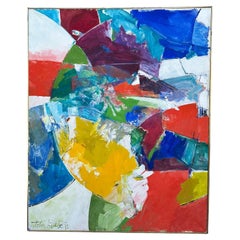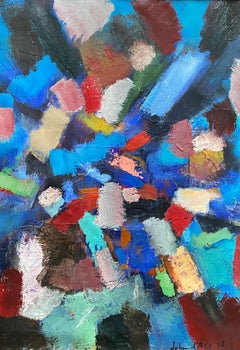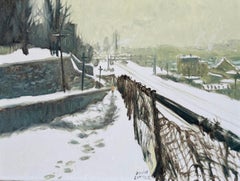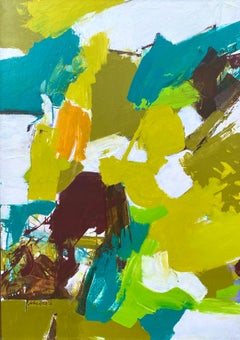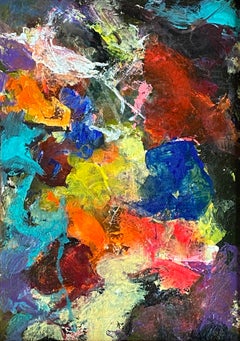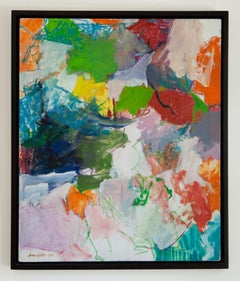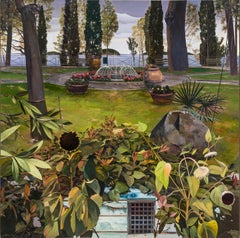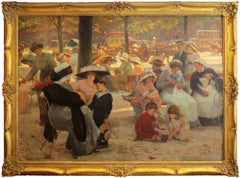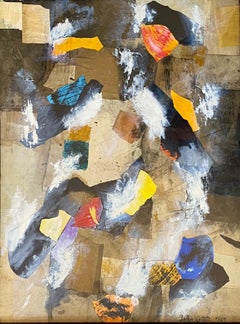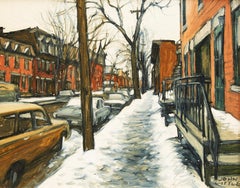John Little Art
American, 1907-1984
Born in Alabama, John Little attended the Buffalo (NY) Fine Arts Academy as a teenager, until 1927. Soon after, he moved to New York where he began operatic vocal training and opened what would become a very successful textile business designing fabric and wallpaper.
In 1933, he enrolled at the Art Students League under the tutelage of George Grosz. Little’s early work consisted predominantly of landscapes, until 1937, when he began studying under Hans Hofmann and his work naturally shifted toward abstraction. During his time with Hofmann, he with artists such as Lee Krasner, George McNeil, Gerome Kamrowski, Giorgio Cavallon, and Perle Fine.
Little entered the the service in 1942 as an aerial photographer for the Navy. Returning to New York after the war and with nowhere to stay, he reconnected with Hofmann and moved into his 8th Street studio, alongside his friend Lee Krasner and her husband Jackson Pollock.
In 1946, Little earned his first solo exhibition at the California Palace of the Legion of Honor in San Francisco, with a subsequent solo exhibition at Betty Parsons Gallery in New York two years later.
In the early 1950s, Little abandoned the flat, linear style in favor of a new aesthetic consisting of the thick, gestural buildup of paint. This stylistic change was concurrent with his move to East Hampton In 1951. This enabled him to continue a close friendship with Krasner and Pollock, who had already left the city in favor of the more rural area around East Hampton. Little and Pollock had a joint exhibition in 1955 at Guild Hall, one year before Pollock’s tragic death.
John Little exhibited extensively during his career, with solo shows at Betty Parsons Gallery (1948), Bertha Schaefer Gallery (1957, 1958), Worth Ryder Gallery (1963), A.M. Sachs Gallery (1971), and a retrospective at the Guild Hall Museum (1982). His work can be found in many private, institutional, and corporate collections around the world, including the Metropolitan Museum of Art, Guild Hall Museum, Ball State University Museum of Art, and Galerie Beyeler.(Biography provided by Waterline Fine Art)
to
4
13
11
1
7
6
1
2
3
6
3
Overall Height
to
Overall Width
to
8
4
1
1
1
1
1
1
1
1
1
1
1
14
2
4
2
1
14
6,961
3,321
2,514
1,213
13
8
5
5
4
Artist: John Little
Space Odyssey
By John Little
Located in Newport Beach, CA
Oil on canvas signed by American artist, John Little (1907-1984) and dated 1970-71 in gilded trimmed, wood frame.
Little, who attended the Buffalo Fine Arts Academy and worked under ...
Category
1970s Abstract John Little Art
Materials
Canvas, Oil
“Untitled”
By John Little
Located in Southampton, NY
Early, original oil on canvas painting by the well known American abstract expressionist artist, John Little. Signed and dated lower right, 1958.
Signed and dated verso. Rose Fried...
Category
1950s Abstract Expressionist John Little Art
Materials
Canvas, Oil
Rue des Seigneurs, Montreal
By John Little
Located in Westmount, QC
John Little, Canadian, b. 1928
Rue des Seigneurs, Montreal
Oil on canvas panel
12 x 16 in
Signed lower right ; signed and titled verso
framed
John Little RCA is a Canadian artist, ...
Category
1980s John Little Art
Materials
Oil
“Double Play”
By John Little
Located in Southampton, NY
Strong, vibrant original oil on canvas painting titled “Double Play” by the well known American artist, John Little. Signed and dated lower left, 1963. Signed, dated and titled vers...
Category
1960s Post-Modern John Little Art
Materials
Canvas, Oil
“Untitled”
By John Little
Located in Southampton, NY
Original oil on canvas painting by the well known abstract expressionist artist, John Little. Signed lower right. Signed and dated 1965 on top stretcher bar verso. Betty Parsons Ga...
Category
1960s Abstract Expressionist John Little Art
Materials
Canvas, Oil
Untitled
By John Little
Located in Austin, TX
Oil on canvas. Signed and dated lower left.
36.25 x 30.25 in.
38.5 x 32.5 in. (framed)
Custom hardwood frame with dark stain. FredEric’s Frame Studio, Chicago.
Provenance
McCormick Gallery, Chicago
Born in Alabama, John Little attended the Buffalo (NY) Fine Arts Academy as a teenager, until 1927. Soon after, he moved to New York where he began operatic vocal training and opened what would become a very successful textile business designing fabric and wallpaper.
In 1933, he enrolled at the Art Students League under the tutelage of George Grosz. Little’s early work consisted predominantly of landscapes, until 1937, when he began studying under Hans Hofmann and his work naturally shifted toward abstraction. During his time with Hofmann, he with artists such as Lee Krasner, George McNeil, Gerome Kamrowski, Giorgio Cavallon...
Category
1960s Abstract Expressionist John Little Art
Materials
Canvas, Oil
White Dawn
By John Little
Located in Austin, TX
Egg emulsion on fiberglass. Signed and dated upper left and verso; titled verso.
49 x 48 in.
49.75 x 49 in. (framed)
Custom framed in hickory.
Provenance
Albright-Knox Art Gallery, Buffalo, NY
Born in Alabama, John Little attended the Buffalo (NY) Fine Arts Academy as a teenager, until 1927. Soon after, he moved to New York where he began operatic vocal training and opened what would become a very successful textile business designing fabric and wallpaper.
In 1933, he enrolled at the Art Students League under the tutelage of George Grosz. Little’s early work consisted predominantly of landscapes, until 1937, when he began studying under Hans Hofmann and his work naturally shifted toward abstraction. During his time with Hofmann, he with artists such as Lee Krasner, George McNeil, Gerome Kamrowski, Giorgio Cavallon...
Category
1960s Abstract Expressionist John Little Art
Materials
Fiberglass, Egg Tempera
Modern Light Blue, Brown, and Black Geometric Abstract Circle Pattern Painting
By John Little
Located in Houston, TX
Modern light blue, brown, and black geometric abstract circle pattern painting by textile designer John Little. The work was created as a proposed design for a wallpaper and features the original color codes in the front lower left corner. Currently hung in a solid black frame with a large white margin.
Dimensions Without Frame: H 32.75 in. x W 35.63 in.
Artist Biography: A painter and textile designer, John Little is best known for gestural works filled with boldly explosive color that reflect the influences of his teacher Hans Hofmann and for his involvement in the Abstract Expressionist movement in East Hampton, where he moved in the late 1940s. In East Hampton Little congregated with Jackson Pollock, Lee Krasner, and the other artists who were the leading innovators in the New York School.
John Little was born in Sanford, Alabama. He left home at the age of fourteen to become an artist, and moved to Buffalo, New York, in 1923. After spending a year working as a stevedore on the docks to save money, he enrolled at the Buffalo Fine Arts Academy and developed an interest in singing. In 1927 he moved to New York City where he continued his vocal work and studied operatic literature. He also became involved in textile design, opening his own store in 1920, called John Little Studios: Fabric and Wallpaper Design. He ran the store until 1950.
In 1933 John Little resumed his painting studies at the Art Students League in New York under the guidance of George Grosz (1893-1959). The following year he made his first visit to East Hampton, Long Island, which he would eventually call home. Later in the decade, he traveled to Paris where he became familiar with European modernism. On his return to America, he taught textile design at the Pratt Institute in Brooklyn. He hired Josephine Watkins to work for him; she later became his wife. Little's textile store and teaching job gave him a financial security that was rare during the Depression, and he never found it necessary to find employment with the Works Progress Administration. At the end of the decade, John Little studied with Hans Hofmann (1880-1966) in New York and Provincetown. Little was greatly influenced by Hofmann, particularly by his views on color theory.
In 1942 John Little joined the Navy as an aerial photographer. In the late 1940s he purchased a rundown house on Three Mile Harbor...
Category
Early 20th Century Modern John Little Art
Materials
Paper, Gouache
Modern Orange, Brown, Yellow, and Black Geometric Abstract Pattern Painting
By John Little
Located in Houston, TX
Modern orange, brown, yellow, and black geometric abstract composition by textile designer John Little. The work was created as a proposed design for a wallpaper and features the original color codes in the front lower left corner. Currently hung in a solid black frame with a large white margin.
Dimensions Without Frame: H 35.5 in. x W 33.5 in.
Artist Biography: A painter and textile designer, John Little is best known for gestural works filled with boldly explosive color that reflect the influences of his teacher Hans Hofmann and for his involvement in the Abstract Expressionist movement in East Hampton, where he moved in the late 1940s. In East Hampton Little congregated with Jackson Pollock, Lee Krasner, and the other artists who were the leading innovators in the New York School.
John Little was born in Sanford, Alabama. He left home at the age of fourteen to become an artist, and moved to Buffalo, New York, in 1923. After spending a year working as a stevedore on the docks to save money, he enrolled at the Buffalo Fine Arts Academy and developed an interest in singing. In 1927 he moved to New York City where he continued his vocal work and studied operatic literature. He also became involved in textile design, opening his own store in 1920, called John Little Studios: Fabric and Wallpaper Design. He ran the store until 1950.
In 1933 John Little resumed his painting studies at the Art Students League in New York under the guidance of George Grosz (1893-1959). The following year he made his first visit to East Hampton, Long Island, which he would eventually call home. Later in the decade, he traveled to Paris where he became familiar with European modernism. On his return to America, he taught textile design at the Pratt Institute in Brooklyn. He hired Josephine Watkins to work for him; she later became his wife. Little's textile store and teaching job gave him a financial security that was rare during the Depression, and he never found it necessary to find employment with the Works Progress Administration. At the end of the decade, John Little studied with Hans Hofmann (1880-1966) in New York and Provincetown. Little was greatly influenced by Hofmann, particularly by his views on color theory.
In 1942 John Little joined the Navy as an aerial photographer. In the late 1940s he purchased a rundown house on Three Mile Harbor...
Category
Early 20th Century Modern John Little Art
Materials
Paper, Gouache
Modern Grey and Orange Geometric Abstract Leaf Pattern Painting
By John Little
Located in Houston, TX
Modern grey and white geometric abstract leaf pattern composition with orange accents by textile designer John Little. The work was created as a proposed design for a wallpaper and features the original color codes in the front lower left corner. Currently hung in a solid black frame with a large white margin.
Dimensions Without Frame: H 27.13 in. x W 31.5 in.
Artist Biography: A painter and textile designer, John Little is best known for gestural works filled with boldly explosive color that reflect the influences of his teacher Hans Hofmann and for his involvement in the Abstract Expressionist movement in East Hampton, where he moved in the late 1940s. In East Hampton Little congregated with Jackson Pollock, Lee Krasner, and the other artists who were the leading innovators in the New York School.
John Little was born in Sanford, Alabama. He left home at the age of fourteen to become an artist, and moved to Buffalo, New York, in 1923. After spending a year working as a stevedore on the docks to save money, he enrolled at the Buffalo Fine Arts Academy and developed an interest in singing. In 1927 he moved to New York City where he continued his vocal work and studied operatic literature. He also became involved in textile design, opening his own store in 1920, called John Little Studios: Fabric and Wallpaper Design. He ran the store until 1950.
In 1933 John Little resumed his painting studies at the Art Students League in New York under the guidance of George Grosz (1893-1959). The following year he made his first visit to East Hampton, Long Island, which he would eventually call home. Later in the decade, he traveled to Paris where he became familiar with European modernism. On his return to America, he taught textile design at the Pratt Institute in Brooklyn. He hired Josephine Watkins to work for him; she later became his wife. Little's textile store and teaching job gave him a financial security that was rare during the Depression, and he never found it necessary to find employment with the Works Progress Administration. At the end of the decade, John Little studied with Hans Hofmann (1880-1966) in New York and Provincetown. Little was greatly influenced by Hofmann, particularly by his views on color theory.
In 1942 John Little joined the Navy as an aerial photographer. In the late 1940s he purchased a rundown house on Three Mile Harbor...
Category
Early 20th Century Modern John Little Art
Materials
Paper, Gouache
Imbrium
By John Little
Located in Lawrence, NY
In 1937, at the age of 20, Little started working with Hans Hofmann in both New York and
Provincetown. This pushed him towards abstraction and his first serious involvement as a
pain...
Category
1950s Abstract Expressionist John Little Art
Materials
Oil
John Little "Wallpaper Studies" Eagles, Flowers, Bunting, Color Code Bar
By John Little
Located in Detroit, MI
SALE ONE WEEK ONLY
"Wallpaper Studies" is just that, a watercolor of a proposed design for a wallpaper with its's color code on the lower left. The painting is of a Nationalistic de...
Category
Mid-20th Century American Modern John Little Art
Materials
Paper, Watercolor
John Little "Blue Nocturne" Abstract Oil Painting
By John Little
Located in Detroit, MI
SALE ONE WEEK ONLY
"Blue Nocturne" is full of rich deep blues contrasted by oranges, red, black and white. The abstract composition is bursting with energy that pours out of the pai...
Category
Late 20th Century Abstract Expressionist John Little Art
Materials
Oil
"Untitled"
By John Little
Located in Southampton, NY
Woodblock by the American artist John Little. Signed and dated in pencil lower right, 1974. Number 11/15. Inscribed "Merry Christmas to Alfred and Harold" in pencil lower right. Condition: excellent. In thin metal frame 29.25 by 33.25 inches.
John Little was born in Sanford, Alabama. He left home at the age of fourteen to become an artist, and moved to Buffalo, New York, in 1923. After spending a year working as a stevedore on the docks to save money, he enrolled at the Buffalo Fine Arts Academy and developed an interest in singing. In 1927 he moved to New York City where he continued his vocal work and studied operatic literature. He also became involved in textile design, opening his own store in 1920, called John Little Studios: Fabric and Wallpaper Design. He ran the store until 1950.
In 1933 John Little resumed his painting studies at the Art Students League in New York under the guidance of George Grosz (1893-1959). The following year he made his first visit to East Hampton, Long Island, which he would eventually call home. Later in the decade, he traveled to Paris where he became familiar with European modernism. On his return to America, he taught textile design at the Pratt Institute in Brooklyn. He hired Josephine Watkins to work for him; she later became his wife. Little’s textile store and teaching job gave him a financial security that was rare during the Depression, and he never found it necessary to find employment with the Works Progress Administration. At the end of the decade, John Little studied with Hans Hofmann (1880-1966) in New York and Provincetown. Little was greatly influenced by Hofmann, particularly by his views on color theory.
In 1942 John Little joined the Navy as an aerial photographer. In the late 1940s he purchased a rundown house on Three Mile Harbor...
Category
1970s Abstract Expressionist John Little Art
Materials
Woodcut
Related Items
Italian Garden in Acadia
By John Moore
Located in New York, NY
Signed (at lower right): MOORE
Category
2010s Contemporary John Little Art
Materials
Oil
"Sunday in the Park, 1910"
By Cyprien Eugène Boulet
Located in Lambertville, NJ
Signed Lower Right
Cyprien-Eugène Boulet (1877 - 1927)
Category
Early 20th Century Impressionist John Little Art
Materials
Canvas, Oil
The Harvest
Located in London, GB
Farmhands working in a field on a hot summer's day.
Building on iconic depictions of farmworkers by Millet, Huys sought to imbue his figures with a sensitivity and reverence that ...
Category
20th Century John Little Art
Materials
Canvas, Oil
A Trail through the Trees
By Albert Bierstadt, 1830-1902
Located in New York, NY
Monogrammed lower left: ABierstadt
Category
19th Century Hudson River School John Little Art
Materials
Board, Oil
Ripples in Space - Abstract Composition Original Oil Painting
Located in Soquel, CA
Ripples in Space - Abstract Composition Original Oil Painting
Vibrant abstract composition of paint, paper, enamel, and glitter by unknown artist "DeZulio" or "Dejulio". Several pie...
Category
Late 20th Century Abstract John Little Art
Materials
Enamel
H 24.75 in W 38 in D 1 in
San Pedro Harbor
By Paul Sample
Located in New York, NY
It is infrequent, to say the least, that a diagnosis of tuberculosis proves fortuitous, but that was the event, in 1921, that set Paul Starrett Sample on the road to becoming a professional artist. (The best source for an overview of Sample’s life and oeuvre remains Paul Sample: Painter of the American Scene, exhib. cat., [Hanover, New Hampshire: Hood Museum of Art, 1988] with a detailed and definitive chronology by Sample scholar, Paula F. Glick, and an essay by Robert L. McGrath. It is the source for this essay unless otherwise indicated.) Sample, born in Louisville, Kentucky, in 1896 to a construction engineer and his wife, spent his childhood moving with his family to the various locations that his father’s work took them. By 1911, the family had landed in Glencoe, Illinois, settling long enough for Paul to graduate from New Trier High School in 1916. Sample enrolled at Dartmouth College, in Hanover, New Hampshire, where his interests were anything but academic. His enthusiasms included the football and basketball teams, boxing, pledging at a fraternity, and learning to play the saxophone. After the United States entered World War I, Sample, to his family’s dismay, signed on for the Naval Reserve, leading directly to a hiatus from Dartmouth. In 1918 and 1919, Sample served in the U.S. Merchant Marine where he earned a third mate’s license and seriously contemplated life as a sailor. Acceding to parental pressure, he returned to Dartmouth, graduating in 1921. Sample’s undergraduate life revolved around sports and a jazz band he formed with his brother, Donald, two years younger and also a Dartmouth student. In November 1933, Sample summarized his life in a letter he wrote introducing himself to Frederick Newlin Price, founder of Ferargil Galleries, who would become his New York art dealer. The artist characterized his undergraduate years as spent “wasting my time intensively.” He told Price that that “I took an art appreciation course and slept thru it every day” (Ferargil Galleries Records, circa 1900–63, Archives of American Art, Smithsonian Institution, available on line).
In 1920, Donald Sample contracted tuberculosis. He went for treatment to the world-famous Trudeau Sanitorium at Saranac Lake, in New York State’s Adirondack Mountains for the prescribed regimen of rest, healthful food, and fresh air. Visiting his brother in 1921, Paul also contracted the disease. Tuberculosis is highly contagious, and had no certain cure before the development of streptomycin in 1946. Even for patients who appeared to have recovered, there was a significant rate of recurrence. Thus, in his letter to Price, Sample avoided the stigma conjured by naming the disease, but wrote “I had a relapse with a bad lung and spent the next four years hospitalized in Saranac Lake.” The stringent physical restrictions imposed by adherence to “the cure” required Sample to cultivate an alternate set of interests. He read voraciously and, at the suggestion of his physician, contacted the husband of a fellow patient for instruction in art. That artist, then living in Saranac, was Jonas Lie (1880–1940), a prominent Norwegian-American painter and an associate academician at the National Academy of Design. Lie had gained renown for his dramatic 1913 series of paintings documenting the construction of the Panama Canal (The Metropolitan Museum of Art, New York; United States Military Academy, West Point, New York). Primarily a landscape artist, Lie had a particular affinity for scenes with water. His paintings, impressionistic, atmospheric, and brushy, never strayed from a realistic rendering of his subject. Sample regarded Lie as a mentor and retained a lifelong reverence for his teacher. Sample’s early paintings very much reflect Lie’s influence.
`
In 1925, “cured,” Sample left Saranac Lake for what proved to be a brief stay in New York City, where his veteran’s benefits financed a commercial art course. The family, however, had moved to California, in the futile hope that the climate would benefit Donald. Sample joined them and after Donald’s death, remained in California, taking classes at the Otis Art Institute in Los Angeles. In Sample’s account to Price, “I couldn’t stomach the practice of painting a lot of High Sierras and desert flowers which seemed to be the only kind of pictures that were sold here so I got a job teaching drawing and painting at the art school of the University of Southern California.” Initially hired as a part-time instructor, Sample progressed to full-time status and ultimately, by the mid-1930s, to the post of Chairman of the Fine Art Department. Sample, however, did not want to wind up as a professor. “Teaching is all right in small doses,” he wrote, “but I have a horror of drifting into being a college professor and nothing more.” At the same time as he taught, Sample began to exhibit his work in a variety of venues at first locally, then nationally. Though he confessed himself “a terrible salesman,” and though occupied with continued learning and teaching, Sample was nonetheless, ambitious. In 1927, he wrote in his diary, “I am eventually going to be a painter and a damned good one. And what is more, I am going to make money at it” (as quoted by Glick, p. 15). In 1928, Sample felt sufficiently solvent to marry his long-time love, Sylvia Howland, who had also been a patient at Saranac Lake. The Howland family were rooted New Englanders and in summertime the Samples regularly traveled East for family reunion vacations.
While the 1930s brought serious hardship to many artists, for Paul Sample it was a decade of success. Buttressed by the financial safety net of his teacher’s salary, he painted realist depictions of the American scene. While his work addressed depression-era conditions with a sympathetic eye, Sample avoided the anger and tinge of bitterness that characterized much contemporary realist art. Beginning in 1930, Sample began to exhibit regularly in juried exhibitions at important national venues, garnering prizes along the way. In 1930, Inner Harbor won an honorable mention in the Annual Exhibition of the Art Institute of Chicago. That same year Sample was also represented in a show at the Albright-Knox Gallery in Buffalo and at the Biennial Exhibition of the Corcoran Gallery of Art, Washington, D.C. In 1931, Dairy Ranch won the second Hallgarten Prize at the Annual Exhibition of the National Academy of Design, in New York. Sample also made his first appearances at the Carnegie Institute, Pittsburgh, and The Pennsylvania Academy of the Fine Arts, Philadelphia. In 1936, Miner’s Resting won the Temple Gold Medal at the Pennsylvania Academy’s Annual Exhibition. Always interested in watercolor, in 1936, Sample began to send works on paper to exhibitions at the Whitney Museum, New York.
While participating in juried exhibitions, Sample also cultivated commercial possibilities. His first New York art dealer was the prestigious Macbeth Gallery in New York, which included his work in a November 1931 exhibition. In 1934, Sample joined the Ferargil Galleries in New York, after Fred Price arranged the sale of Sample’s Church Supper to the Michele and Donald D’Amour Museum of Fine Arts in Springfield, Massachusetts. In 1937, The Metropolitan Museum of Art purchased Sample’s Janitor’s Holiday from the annual exhibition of the National Academy of Design, a notable honor.
As prestigious as this exhibition schedule may have been, by far Sample’s most visible presence in the 1930s and 1940s was the result of his relationship with Henry Luce’s burgeoning publishing empire, Time, Inc. Sample’s first contribution to a Luce publication appears to have been another San Pedro...
Category
20th Century American Modern John Little Art
Materials
Canvas, Oil
'The Eagle' - Orange and White Large Bird - Abstract Expressionist Oil Painting
By David Leviathan
Located in Carmel, CA
"The Phoenix" by David Leviathan is a 28" x 40" oil on canvas that embodies the essence of abstract animal painting. In this work, Leviathan utilizes a palette of soft whites, creams, and earth tones, accented with vibrant strokes of red and gold, to depict the mythical bird rising from the ashes. The painting's style is characterized by sweeping, textured brushstrokes that convey the fiery rebirth and dynamic movement of the phoenix. The composition radiates a sense of renewal and hope, capturing the transformative power of nature and myth. Leviathan's approach is both evocative and ethereal, inviting viewers to consider themes of resilience, rejuvenation, and the cyclical nature of life.
About the Artist:
David Leviathan, born on August 6, 1950, in Kibbutz Givat Brenner, Israel, is a multifaceted Israeli artist whose talents span painting, sculpture, and poetry. After serving in the military, he studied at the Avni Institute of Fine Arts and worked under the guidance of Yehezkel Streichman...
Category
Early 2000s Abstract Expressionist John Little Art
Materials
Canvas, Oil
David Leviathan'The Eagle' - Orange and White Large Bird - Abstract Expressionist Oil Painting, 2005
H 28 in W 40 in D 0.75 in
"Mountain Labyrinths"
By John F. Carlson
Located in Lambertville, NJ
Ashley John is proud to offer this artwork by:
John Fabian Carlson (1874/75 - 1945)
John F. Carlson was one of the leading American landscape p...
Category
Early 20th Century Tonalist John Little Art
Materials
Canvas, Oil
'Steinbeck Re-Visited' - Portrait of John Steinbeck - Geometric Portrait
Located in Carmel, CA
"Steinbeck Re-Visited" by Robert Glick is a 20" x 16" oil on canvas that gracefully intersects the realms of contemporary abstract expressionism and geome...
Category
2010s Abstract Expressionist John Little Art
Materials
Canvas, Oil
Free Shipping
H 20 in W 16 in D 0.75 in
'Agay, le château et le Sémaphore'. Oil on canvas. Signed.
By Armand Guillaumin
Located in Paris, FR
'Agay, le château et le Sémaphore'.
Oil on canvas. +/- 1922
Signed lower right
Measurements : 60 x 73 cm.
This painting will be recorded in the second volume of the Catalogue Raisonn...
Category
1920s Impressionist John Little Art
Materials
Oil
H 23.63 in W 28.75 in
Strawberries Strewn on a Forest Floor
By William Mason Brown
Located in New York, NY
William Mason Brown was born in Troy, New York, where he studied for several years with local artists, including the leading portraitist there, Abel Buel Moore. In 1850, he moved to ...
Category
19th Century American Realist John Little Art
Materials
Canvas, Oil
'Allez!' At the Match. Toulon Rugby Club. Large Expressionist Oil on Canvas.
Located in Cotignac, FR
Large abstract expressionist oil on canvas of Toulon Rugby Club supporters at a rugby match. Unsigned.
Extremely vibrant and energetic depiction of Toulon ...
Category
Late 20th Century Abstract Expressionist John Little Art
Materials
Canvas, Oil
H 35.24 in W 45.67 in D 0.79 in
Previously Available Items
“Abstract Collage”
By John Little
Located in Southampton, NY
Original mixed media painting composed of acrylic paint and paper collage on heavy card stock by the well known American artist, John Little. Signed lower right and dated 1969. Cond...
Category
1960s Abstract Expressionist John Little Art
Materials
Paper, Acrylic, Cardboard
Montreal
By John Little
Located in Westmount, QC
John Little, Canadian, b.1928
Montreal
Oil on canvas
8 x 10 in
John Little
b. 1928
UNTITLED
1987
Oil on canvas
8 x 10 in
20.3 x 25.4 cm
signed lower right; signed, titled and dated ...
Category
1980s John Little Art
Materials
Oil
"Ground Pine" Modern Green, Grey, & Pink Abstract Leaf Pattern Textile Painting
By John Little
Located in Houston, TX
Modern green, grey, and pink abstract leaf pattern painting by textile designer John Little. The work was created as a proposed design for a wallpaper and features the original color codes in the front lower left corner. Currently hung in a solid black frame with a large white margin.
Dimensions Without Frame: H 27.25 in. x W 35.5 in.
Artist Biography: A painter and textile designer, John Little is best known for gestural works filled with boldly explosive color that reflect the influences of his teacher Hans Hofmann and for his involvement in the Abstract Expressionist movement in East Hampton, where he moved in the late 1940s. In East Hampton Little congregated with Jackson Pollock, Lee Krasner, and the other artists who were the leading innovators in the New York School.
John Little was born in Sanford, Alabama. He left home at the age of fourteen to become an artist, and moved to Buffalo, New York, in 1923. After spending a year working as a stevedore on the docks to save money, he enrolled at the Buffalo Fine Arts Academy and developed an interest in singing. In 1927 he moved to New York City where he continued his vocal work and studied operatic literature. He also became involved in textile design, opening his own store in 1920, called John Little Studios: Fabric and Wallpaper Design. He ran the store until 1950.
In 1933 John Little resumed his painting studies at the Art Students League in New York under the guidance of George Grosz (1893-1959). The following year he made his first visit to East Hampton, Long Island, which he would eventually call home. Later in the decade, he traveled to Paris where he became familiar with European modernism. On his return to America, he taught textile design at the Pratt Institute in Brooklyn. He hired Josephine Watkins to work for him; she later became his wife. Little's textile store and teaching job gave him a financial security that was rare during the Depression, and he never found it necessary to find employment with the Works Progress Administration. At the end of the decade, John Little studied with Hans Hofmann (1880-1966) in New York and Provincetown. Little was greatly influenced by Hofmann, particularly by his views on color theory.
In 1942 John Little joined the Navy as an aerial photographer. In the late 1940s he purchased a rundown house on Three Mile Harbor...
Category
Early 20th Century Modern John Little Art
Materials
Paper, Gouache
H 28.75 in W 37.13 in D 1.13 in
"New Yorker" Modern Minimal Blue & Tan Abstract Painting of Museum of Modern Art
By John Little
Located in Houston, TX
Modern minimal blue and tan line drawing inspired the Museum of Modern Art in New York City by textile designer John Little. The work features renderings of Constantin Brancusi's "Ml...
Category
Early 20th Century Modern John Little Art
Materials
Ink, Paper, Gouache
H 37.13 in W 55 in D 1.13 in
Modern Purple, Light Blue, and Gray Geometric Abstract Leaf Pattern Painting
By John Little
Located in Houston, TX
Modern purple, light blue, and gray geometric abstract painting of a leaf pattern by textile designer John Little. The work was created as a proposed design for a wallpaper. Currentl...
Category
Early 20th Century Modern John Little Art
Materials
Paper, Gouache
H 33.13 in W 33.13 in D 1.13 in
"Idioms" Modern Orange, Brown, Gray, and Black Geometric Abstract Painting
By John Little
Located in Houston, TX
Modern orange, brown, gray, and black geometric abstract composition by textile designer John Little. The work was created as a proposed design for a wallpaper. Titled in pencil along front lower margin. Currently hung in a solid black frame with a large white margin.
Dimensions Without Frame: H 31.63 in. x W 31.63 in.
Artist Biography: A painter and textile designer, John Little is best known for gestural works filled with boldly explosive color that reflect the influences of his teacher Hans Hofmann and for his involvement in the Abstract Expressionist movement in East Hampton, where he moved in the late 1940s. In East Hampton Little congregated with Jackson Pollock, Lee Krasner, and the other artists who were the leading innovators in the New York School.
John Little was born in Sanford, Alabama. He left home at the age of fourteen to become an artist, and moved to Buffalo, New York, in 1923. After spending a year working as a stevedore on the docks to save money, he enrolled at the Buffalo Fine Arts Academy and developed an interest in singing. In 1927 he moved to New York City where he continued his vocal work and studied operatic literature. He also became involved in textile design, opening his own store in 1920, called John Little Studios: Fabric and Wallpaper Design. He ran the store until 1950.
In 1933 John Little resumed his painting studies at the Art Students League in New York under the guidance of George Grosz (1893-1959). The following year he made his first visit to East Hampton, Long Island, which he would eventually call home. Later in the decade, he traveled to Paris where he became familiar with European modernism. On his return to America, he taught textile design at the Pratt Institute in Brooklyn. He hired Josephine Watkins to work for him; she later became his wife. Little's textile store and teaching job gave him a financial security that was rare during the Depression, and he never found it necessary to find employment with the Works Progress Administration. At the end of the decade, John Little studied with Hans Hofmann (1880-1966) in New York and Provincetown. Little was greatly influenced by Hofmann, particularly by his views on color theory.
In 1942 John Little joined the Navy as an aerial photographer. In the late 1940s he purchased a rundown house on Three Mile Harbor...
Category
Early 20th Century Modern John Little Art
Materials
Paper, Gouache
H 33.13 in W 33.13 in D 1.13 in
"Untitled"
By John Little
Located in Southampton, NY
Watercolor on paper laid down on panel. Executed in 1973 by the American artist John Little. Signed lower right in pencil and dated 1973. Inscribed verso "Merry Chrismas Harold and Alfred, John". A note on from the artist is included. See photo. The Watercolor on paper laid down on panel. Executed in 1973 by the American artist John Little. Signed lower right in pencil and dated 1973. Inscribed verso ' Merry Chrismas Harold and Alfred, John" A note from the artist is included. See photo. The artwork is in a handcrafted frame made by the artist. Condition is good. Has several small waves in paper. Slight fold lower right corner; slight natural toning of paper. No glass. Overall framed size 17.5 by 13.5 inches.
John Little was born in Sanford, Alabama. He left home at the age of fourteen to become an artist, and moved to Buffalo, New York, in 1923. After spending a year working as a stevedore on the docks to save money, he enrolled at the Buffalo Fine Arts Academy and developed an interest in singing. In 1927 he moved to New York City where he continued his vocal work and studied operatic literature. He also became involved in textile design, opening his own store in 1920, called John Little Studios: Fabric and Wallpaper Design. He ran the store until 1950.
In 1933 John Little resumed his painting studies at the Art Students League in New York under the guidance of George Grosz (1893-1959). The following year he made his first visit to East Hampton, Long Island, which he would eventually call home. Later in the decade, he traveled to Paris where he became familiar with European modernism. On his return to America, he taught textile design at the Pratt Institute in Brooklyn. He hired Josephine Watkins to work for him; she later became his wife. Little’s textile store and teaching job gave him a financial security that was rare during the Depression, and he never found it necessary to find employment with the Works Progress Administration. At the end of the decade, John Little studied with Hans Hofmann (1880-1966) in New York and Provincetown. Little was greatly influenced by Hofmann, particularly by his views on color theory.
In 1942 John Little joined the Navy as an aerial photographer. In the late 1940s he purchased a rundown house on Three Mile Harbor...
Category
1970s Abstract Expressionist John Little Art
Materials
Paper, Watercolor
John Little art for sale on 1stDibs.
Find a wide variety of authentic John Little art available for sale on 1stDibs. If you’re browsing the collection of art to introduce a pop of color in a neutral corner of your living room or bedroom, you can find work that includes elements of purple and other colors. You can also browse by medium to find art by John Little in paint, oil paint, paper and more. Much of the original work by this artist or collective was created during the 20th century and is mostly associated with the abstract style. Not every interior allows for large John Little art, so small editions measuring 10 inches across are available. Customers who are interested in this artist might also find the work of Richard Andres, Robert Goodnough, and Norman Carton. John Little art prices can differ depending upon medium, time period and other attributes. On 1stDibs, the price for these items starts at $1,200 and tops out at $40,000, while the average work can sell for $7,700.
